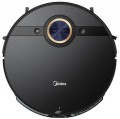Automatic power control
The
automatic power control function is found mainly in robot vacuum cleaners. When driving onto the carpet, the vacuum cleaner automatically increases motor speed and suction power to achieve proper cleaning results. Usually robot vacuum cleaners that support this mode are equipped with a turbo brush and a spacious dust container. It must be taken into account that when cleaning carpets at high power, the battery life of the vacuum cleaner is reduced.
multi-map memory
Advanced models of robotic vacuum cleaners can have
multi-map memory. Thanks to this feature, when moving the robot to another floor, it does not need to reacquaint itself with the premises and build a new map. As a result, cleaning will be done faster and better.
Battery voltage
The rated voltage of the battery used in the vacuum cleaner with the corresponding type of power supply (see above).
Initially, manufacturers select the characteristics of the battery (including voltage) in such a way that the vacuum cleaner can be guaranteed to deliver the power claimed in the specifications. Therefore, when choosing this indicator often does not play a decisive role. However, it can also be useful in such cases — for the most reliable comparison between models with different battery capacities in ampere-hours. See "Battery capacity" for details.
In addition, voltage data can be useful during operation — for example, to find a spare/replacement battery or a third-party charger.
Charging time
The time required to charge the cordless vacuum cleaner fully (see "Power supply").
Larger batteries tend to take longer to charge. On the other hand, modern batteries can use various solutions that speed up the process, so there is no strict dependence here.
Separately, we note that the speed of charging batteries is usually uneven: at first, the process is fast, then it gradually slows down. So if, for example, the specifications indicate a charging time of 2 hours, then charging from 0 to 50% will take a little less than an hour, and from 50% to 100% the remaining time.
Docking station with dust collector
Docking station with dust container. Upon getting to such a stand, the robot can recharge the battery and carry out self-cleaning — unloading the collected garbage into an external container. The capacity of the station is enough for several unloadings. The convenience of this function is obvious: it allows the device to work longer without user intervention and eliminates the need to manually clean the vacuum cleaner when the dust container is full (besides, unloading garbage from the dock is usually easier than such cleaning). Unfortunately, such a feature is quite expensive. There are also upright vacuum cleaners with a similar station. In such models, the cleaning is carried out with minimal human intervention - you only need to install the vacuum cleaner in the docking station. The self-cleaning mode independently moves the debris from the dust collector of the device to the dust container of the station.
Noise level
The noise level produced by the vacuum cleaner during operation. Usually, the value for normal operation at maximum engine power is indicated here. With less power, the loudness of the unit may be lower, but the key is precisely the maximum indicator.
Regarding specific numbers, keep in mind that the decibel used to measure the noise level is a non-linear quantity. Therefore, it is worth evaluating specific indicators using special comparative tables. In general, vacuum cleaners are quite noisy appliances; so in this case, models are considered quiet if this indicator
does not exceed 65 dB — this is the level of a loud conversation between 2 – 3 people at a distance of 1 m. The quietest of these models give out only 40 dB — this is the average volume of a person’s speech in normal tones (and the minimum volume allowed for constant noise sources in living quarters during the day). For louder units, the comparison table looks like this:
—
66 – 70 dB — loud conversations between several groups of people at a distance of about 1 m;
—
71 – 75 dB — the volume of a cry or laughter in full voice at a distance of about 1 m;
—
76 – 80 dB — the volume of a mechanical alarm clock or the engine of an old truck;
—
more than 80 dB — a very high noise level, exceeding the level of a loud scr
...eam; when working with a vacuum cleaner having such specifications for a long time, it is highly desirable to use hearing protection.
Also note that the noise level largely depends on the engine power, as well as some other features (for example, it is strongly affected by the presence of an aquafilter — see "Dust collector"). At the same time, there is no hard connection here, and units with a similar set of specifications can differ markedly in actual loudness. In such cases, when choosing here, it is worth proceeding from the fact that a quieter vacuum cleaner will be more comfortable to use. However, it will most likely cost noticeably more.
